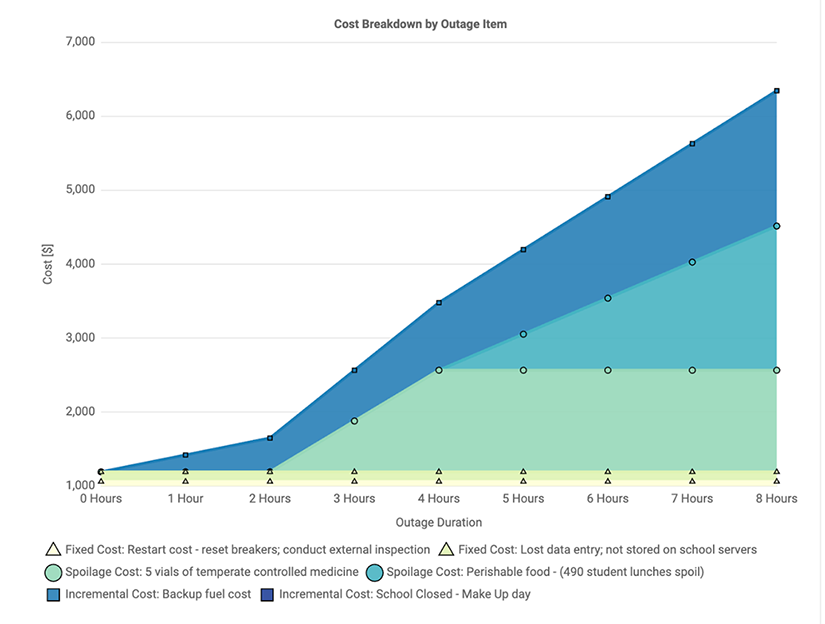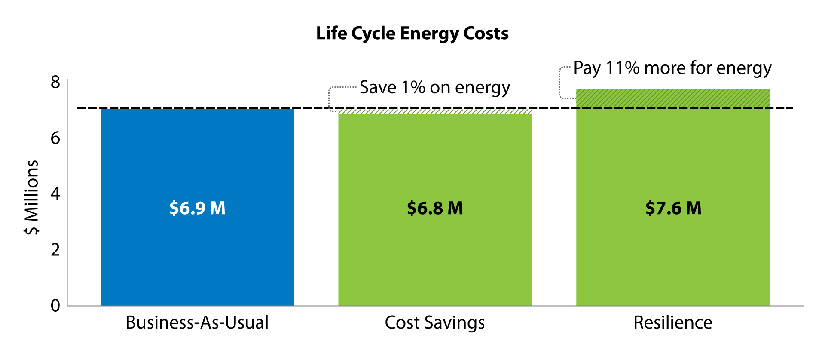Interpreting REopt Results
REopt® provides dozens of outputs to help users understand the cost and value of onsite energy systems at their facilities.
Net present value is one of the most important results provided by REopt and requires careful consideration when evaluating potential energy investments. Net present value (NPV) is the total economic value expected to be produced by a system when its lifecycle costs are subtracted from the energy bill savings it will generate.
A positive NPV indicates that the onsite energy system recommended by REopt will save the facility more money on energy bills than it costs in installation and maintenance over its 25-year lifetime. Systems with positive NPVs save more than they cost and are therefore simpler to justify to decision makers tasked with approving energy investments.
A negative NPV indicates that the onsite energy system recommended by REopt will cost the facility more money in installation and maintenance than it will save on energy bills over its 25-year lifetime. However, it is important to consider that while system costs can be easily tallied, system benefits are challenging to quantify. Systems with negative NPVs may provide resilience and clean energy benefits worth more than the systems cost, but the negative NPVs may not reflect that reality. In these cases, system benefits must be clearly communicated to decision makers.
Try this: Compare the System Sizes and Net Present Value for energy systems designed to meet three different goals: resilience, clean energy, and cost savings. Which goal leads to the largest battery? Which goal leads to the most expensive system?
System Size
Net Present Value
Emissions Reduction
Valuing Resilience
Decision makers can review REopt results to determine which onsite energy investments best serve community goals and then justify those investments in grants and financing applications. Justification for energy resilience investments may need to consider more than economic benefits. On-site energy systems designed to power a facility through grid outages may not pay for themselves through bill savings; they may have negative net present values in REopt when only energy costs are considered. However, these systems may provide resilience benefits that are worth the cost for community members, especially if the system can be funded through grants or low-interest loans.
While research has estimated the economic value of clean energy benefits by accounting for the health and economic costs of emissions, the value of resilience is difficult to quantify. For example, what is the economic value of maintaining shelter and recreation services during a grid outage? What is the economic impact of not having shelter and recreation services for a 72-hour period? Answers will vary depending on the facility, location, and type of outage considered, and these questions can be especially difficult to address for facilities that have not experienced a recent outage.
The National Renewable Energy Laboratory's Customer Damage Function Calculator can help stakeholders brainstorm the costs of outages at different types of facilities to start answering these questions. The tool estimates the number and duration of outages expected to occur for a given location and allows users to inventory potential costs incurred during outages of varying length.

The CDF Calculator divides outage costs into fixed costs, spoilage costs, and incremental costs to help users visualize how a facility's costs evolve as an outage continues. For example, outage costs at a school are relatively low until the outage exceeds 8 hours; at that point, the school must schedule a make-up day and pay staff for the additional time. In an area where an 8-hour power outage is expected to occur each year, these costs could represent a significant proportion of the school's annual expenditures, and the value of an onsite system designed to avoid these costs would be more valuable.
However, quantitative cost-benefit analysis cannot capture all the considerations important for resilience decision-making. Resilience benefits and outage impacts should also be characterized qualitatively. For example, who relies on shelter and recreation services in your community? What kinds of community activities would be impacted without access to shelter and recreation?
Finally, the cost of resilient onsite energy systems can be communicated as a fraction of a facility's annual operating budget. This approach allows stakeholders to consider energy resilience as a necessary expenditure and understand how that expense fits into a facility's larger financial context, even when REopt shows the system's net present value as negative.

Learn more about valuing resilience at critical facilities in the REopt for Resilience: Valuing Resilience webinar.